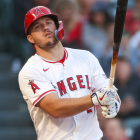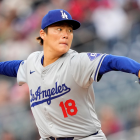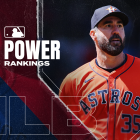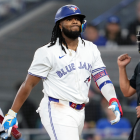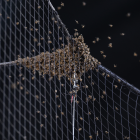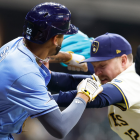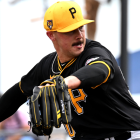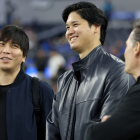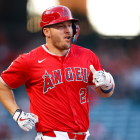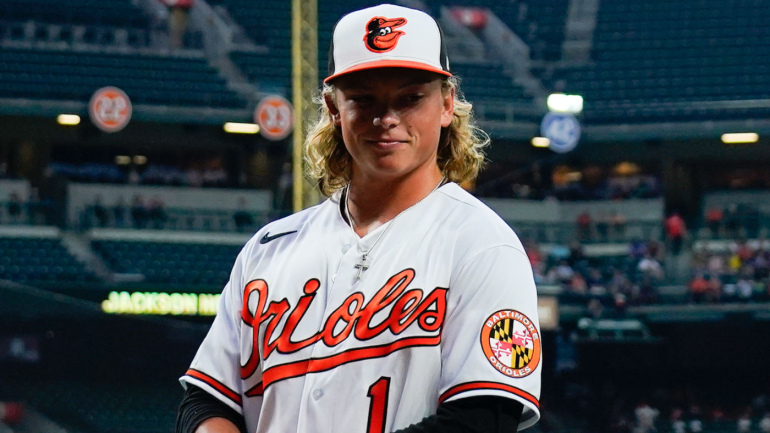
With Major League Baseball's postseason coming to an end, it's time to look forward. For many teams, that means surveying the free-agent and trade markets and identifying who can put them over the top. For others, that means focusing on the bigger picture by assessing players who will not make their debuts until next season, at the earliest. We'll spend plenty of time focusing on the former; today, it's time to look at the latter and rank some prospects.
Below, you'll find CBS Sports' ranking of the top 25 minor-league prospects. (CBS Sports will publish the rest of its top 50 rankings come springtime, after all 30 team lists have been released.) These rankings are formed after conversations with scouts, analysts, and player development specialists.
Bear in mind that different people have different assessments of players. It's not a big deal if a player is ranked higher or lower by another publication. There's room for all. Besides, this is an art, not a science.
With that out of the way, let's get to it. (Note that players' ages are listed as of April 1, 2024.)
1. Jackson Holliday, SS, Orioles (20 years old)
- The short version: Precocious lefty-swinging shortstop with superstar potential.
- MLB ETA: Spring 2024
Holliday should not be able to exceed expectations. He was the No. 1 pick in the 2022 draft, and his father Matt was a seven-time All-Star. He should be burdened with unobtainable forecasts. Yet Holliday has consistently bested the best-case scenario since his high school senior year. In his first full professional season, he blazed through three levels, closing out with an 18-game stint in Triple-A. There, he batted .267/.396/.400 with a 90 mph average exit velocity. He was 19 years old. All of Holliday's indicators, statistical and otherwise, are neon green. He has every tool and intangible necessary to become a star, even if he might require some time to upscale his power from the "gap" to the "over-the-fence" variety. (He needs to add more muscle and loft.) Given his demonstrated ability to overachieve, it would be foolish to bet against him making an impact at the big-league level in 2024. There is, in our estimation, simply no better prospect in the minor leagues.
2. Junior Caminero, 3B, Rays (20 years old)
- The short version: Massive raw power with the glove to stick at third.
- MLB ETA: Debuted in 2023
Caminero is already the answer to a fun trivia question: who did the Rays obtain when they traded right-hander Tobias Myers to the Guardians in November 2021? OK, so folks are more likely to ask the inverse of that question. Caminero has an incredibly fast bat. It doesn't matter that he wraps the barrel; he's able to generate big-time exit velocities and easy power. (His first big-league home run demonstrated how the ball sails off his bat.) He does have an overaggressive approach at the plate, and he was pounding the ball into the sand more than 50% of the time at Double-A before the Rays skipped him to the majors. (To be clear: he was still on a 40-homer pace despite that grounder rate.) Vladimir Guerrero Jr. and Jordan Walker are just two players who have faced questions about maximizing their strength by adding lift. They've worked out just fine. The difference between Camerino and those lads is that he has the athleticism and arm to stick at the hot corner. It's unfair to compare any prospect to Austin Riley, but a more polished Caminero could get close.
3. Evan Carter, CF, Rangers (21 years old)
- The short version: Uber-disciplined outfielder with feel for barrel
- MLB ETA: Debuted in 2023
Carter, who didn't partake in many showcase circuit events as an amateur, was a relative unknown when the Rangers selected him in the second round of the 2020 draft. Initial criticism gave way to fast-and-furious mea culpas once area scouts who saw him that spring started to spread The Word. Carter has since introduced himself to the world on a national stage during the postseason. He has an excellent command over the strike zone (if anything he could stand to be more aggressive) and feel for making solid contact. He's also a speedy runner who can play all three outfield positions.
Evan Carter is HIM!!
— FOX Sports: MLB (@MLBONFOX) October 28, 2023
The @Rangers are on the board first in Game 1!
📺: FOX pic.twitter.com/QB2VPD8JcF
The main question left about his game entails his power potential. Whatever the resolution, he's going to remain an important part of the Rangers lineup for years to come.
4. Wyatt Langford, OF, Rangers (22 years old)
- The short version: The No. 4 pick is already knocking on MLB's door.
- MLB ETA: Spring 2024
CBS Sports ranked Langford as the No. 2 player in the draft class last summer, noting that he would've been a quality No. 1 pick most years. It's to be seen how his big-league career pans out, but he validated our belief in him as much as he possibly could have in 44 minor-league games. Langford hit .360/.480/.677 with 10 home runs, 12 stolen bases, and two more walks than strikeouts split across four levels, including a five-game cameo in Triple-A. He has unorthodox swing mechanics -- he barely loads his hands and he steps in the bucket -- yet scouts have felt confident giving him plus offensive projections even before he took a pro at-bat. Langford also possesses sneaky speed, and there was some thought he would be able to begin his big-league career in center. He's unlikely to receive that opportunity with the Rangers, though it's possible he gets the chance to make the team out of camp.
5. Dylan Crews, OF, Nationals (22 years old)
- The short version: The best prospect in the draft is a well-rounded player.
- MLB ETA: Summer 2024
One question we contemplate each winter is how to weigh a player's introduction to pro ball. Crews was considered to be the best player in the class by the talent evaluators who spoke to CBS Sports last draft cycle. As such, is it reasonable to move him below Langford after just a few months? We decided yes for two main reasons: 1) Langford's dominance at every step; and 2) Crews' underperforming contact rates. Despite batting .405/.545/.685 with more walks than strikeouts against SEC competition, he experienced turbulence in 20 games at Double-A, posting a .595 OPS and connecting on just 70% of his swings. There's no sense overreacting to a small sample when there's years upon years of data demonstrating Crews' competency, but we do think it's important to incorporate every new piece of information. Based on that, we decided to roll with Langford ahead of Crews at this point in time.
6. James Wood, OF, Nationals (21 years old)
- The short version: Towering outfielder with great patience and power.
- MLB ETA: Summer 2024
Wood, the key to the Juan Soto trade from the Nationals' perspective, is a fascinating prospect. He's listed at 6-foot-6 and 240 pounds and he's already capable of massive displays of raw power. (Six of his 28 home runs were hit to left or left-center field.) And yet, take one look at him and it's clear that he has room on his frame to add even more muscle over the coming years. As that comes to fruition, two other developments will take place: 1) he'll outgrow center field, and 2) he'll turn into one of the best sluggers in baseball. The one potential snag here is that Wood's combination of length and patience makes him extremely prone to strikeouts. He punched out in nearly 34% of his trips to the plate in Double-A, which would've qualified as the highest rate in the majors. His on-base and slugging potential will enable him to remain productive even with a poor strikeout rate, but there's superstar upside here if he can get it closer to 30% before he reaches the majors.
7. Jackson Chourio, CF, Brewers (20 years old)
- The short version: Legit center fielder with big-time homer-steal potential.
- MLB ETA: Summer 2024
Chourio, the breakout star of the 2022 minor-league season, is a dynamic talent. He's the rare player who can launch opposite-field home runs with regularity, as well as put infielders in a blender on would-be routine grounders. (There was a game in late April against the Angels' Double-A affiliate where he recorded infield singles to the shortstop and the third baseman in consecutive frames.) Some evaluators have expressed hit-tool concerns generated by his aggressive approach. It's a fair consideration, but Chourio has earned the benefit of the doubt by holding his own in the upper minors at such a young age. If everything clicks, he'll provide the Brewers with their fifth 30/30 season. And their sixth, their seventh, their eighth, and so on.
8. Ethan Salas, C, Padres (17 years old)
- The short version: Shockingly polished defender with offensive upside.
- MLB ETA: Summer 2024
A teenager has not caught at the big-league level since Iván Rodríguez did so in 1991. Salas is going to change that. He has until June 2026 to do it, too. The Padres had him catch during a big-league exhibition game last spring and he did not look out of place despite at the time being a 16-year-old entering his first pro season. Salas is more than a preternaturally gifted receiver. He showed good contact chops throughout his first season, and he even launched nine home runs in 48 games at A-ball. (Four of those were to center.) The Padres pushed him along at an aggressive pace, letting him close out the year with a nine-game sampling of Double-A. It's reasonable to think that his bat is going to lag as a result of San Diego's apparent fast-track development plan; the aforementioned Rodríguez was not close to being a league-average hitter until his third big-league season. Still, Salas' defense should keep him in the lineup. It's unwise to make big bets on young catchers, who are oftentimes as prone to attrition as their batterymates. Salas appears to be the exception.
9. Walker Jenkins, OF, Twins (19 years old)
- The short version: The best prep bat in the draft fits the right-field blueprint.
- MLB ETA: Late 2026
The 2023 draft was portrayed as a five-player class at the top. Jenkins may have gone last among that group on draft night, but it would be unwise to sleep on his offensive potential. He already possesses a feel for making contact and for minding the strike zone, and his 6-foot-3 frame should enable him to add muscle as he matures. That, in turn, could unlock 70-grade raw power upside. The Twins allowed Jenkins to play center field in his introduction to pro ball. Most scouts expect him to end up in a corner before he reaches the majors, with right field considered to be the favored landing spot because of his arm.
10. Paul Skenes, RHP, Pirates (21 years old)
- The short version: The No. 1 pick is a prototypical power pitcher.
- MLB ETA: Summer 2024
Skenes went No. 1 in July's draft on the basis of his power arsenal and his proximity to the majors. His fastball clocked in around 98 mph during a late-season appearance in the Florida State League, and his slider has proven to be an effective chase offering. Turns out he didn't strike out nearly 48% of the batters he faced during SEC play by accident. Even so, Skenes was more polarizing in scouting circles than the above information indicates. His fastball's shape has "dead zone" properties, a fancy way of saying it's easier to track because of a similar amount of vertical and horizontal movement.
Paul Skenes throws gas. pic.twitter.com/NNEmf2ixOT
— Young Bucs (@YoungBucsPIT) August 15, 2023
That blemish won't keep Skenes from having a big-league career -- Nathan Eovaldi and Hunter Greene both have "dead zone" fastballs -- but it may cause his fastball to be less effective than it should be based on pure velocity.
11. Colson Montgomery, SS, White Sox (22 years old)
- The short version: Sweet-swinging lefty shortstop had injuries delay debut.
- MLB ETA: Spring 2024
Montgomery was sidelined by back and oblique issues until June, delaying his big-league arrival until next season. He still made his way to Double-A, where he batted .244/.400/.428 in 37 contests -- not his usual triple-slash excellence, but understandable given the layoff. Montgomery has long inspired comparisons to Corey Seager. While those arise at least in part from superficial reasons -- they have similar builds and facial structures -- Montgomery's feel for hitting and budding strength suggest he could become a plus bat. He should slot in sometime in 2024 as the White Sox's successor to Tim Anderson.
12. Jackson Merrill, SS, Padres (20 years old)
- The short version: Contact-driven lefty with expanding defensive versatility.
- MLB ETA: Summer 2024
The Padres made three of the first 75 picks in the 2021 draft. Two of their selections (James Wood and Robert Gasser) have since been traded as part of deals for Juan Soto and Josh Hader. Merrill, the highest drafted of the three, remains in the organization. He should soon become part of the big-league lineup. Merrill connected on more than 80% of his swings last season, resulting in a cumulative .277/.326/.444 slash line across High- and Double-A. His ability to put the bat on the ball is his top selling point. He does have some power, but it's almost exclusively to his pull side, and it's hard to see him displacing Xander Bogaerts as the Padres' everyday shortstop. San Diego started playing Merrill at other positions down the stretch, including at first and second base and out in left field. If he remains with the Padres into next season -- and, as Wood and Gasser illustrate, you can never say for sure -- he could begin his pro career in more of a utility-starter role.
13. Carson Williams, SS, Rays (20 years old)
- The short version: Great power and glove obscure hit-tool questions
- MLB ETA: Late 2024
Williams is a surefire shortstop with well-above-average raw power. Even these days, that's a rare combination to find. (There've only been seven 30-plus home-run seasons by shortstops since 2021.) He's not higher on this list because there is reason to have skepticism about his hit tool. Williams connected on less than 70% of his swings this season. That, plus his tendency to work deep counts, means he'll always be strikeout-prone. If Williams can keep his K rate on the sunny side of 30% as he climbs the ladder, he'll produce at a star-level. Shy of that, he should still become a flashy everyday starter.
14. Noelvi Marte, 3B, Reds (22 years old)
- The short version: Usability questions plague innate physical traits.
- MLB ETA: Debuted in 2023
CBS Sports has and will continue to be higher on Marte than most shops because of the notion that it's easier to teach a batter how to lift the ball than it is to teach him how to strike the ball with authority. Predictably, Marte can really sting the ball. His 115.6 mph maximum exit velocity placed him in a virtual tie with Bryce Harper and Pete Alonso. The catch is that the only qualified batter with a lower average launch angle than Marte's 1.9 degrees was Pirates utility player Ji Hwan Bae.
How about another Noelvi Marte highlight? @MarteNoelvi pic.twitter.com/BwCVqkikLQ
— Cincinnati Reds (@Reds) August 27, 2023
There are two paths forward for him: either he learns to lift the ball, or he tries to emulate the likes of Yandy Díaz, William Contreras, and Christian Yelich -- all of whom had great years with average launch angles below six degrees. The former scenario is more intriguing, and could result in him launching 30-plus home runs a pop. The latter path, meanwhile, could lead to a perfectly fine career, too. Either way, we believe.
15. Brooks Lee, SS/3B, Twins (23 years old)
- The short version: Polished left-side infielder.
- MLB ETA: Spring 2024
Lee, the eighth pick in the 2022 draft, is an instinctual player and a near lock to become a solid regular. He's a nominal switch-hitter who possesses a better feel for contact and power from the left side. His surface-level statistics at Triple-A were underwhelming (.237/.304/.428 in 38 games), but his ball-tracking metrics (again, primarily as a lefty) suggested he deserved better. To wit, more than half of Lee's batted balls versus righties had an exit velocity that exceeded 95 mph. Scouts have pegged him as a future third baseman since his amateur days because of his lackluster burst and range. Carlos Correa's presence is another impediment. Nevertheless, Lee should slot into the big-league lineup most days beginning early in the 2024 season.
16. Pete Crow-Armstrong, CF, Cubs (22 years old)
- The short version: Brilliant defensive outfielder with some offensive upside.
- MLB ETA: Debuted in 2023
Crow-Armstrong, acquired from the Mets at the 2021 deadline for Javier Báez, is one of the game's best young defensive outfielders. He moves well and throws well, and he should be in contention for a Gold Glove Award beginning in 2024. That much is certain. What's less sure is how Crow-Armstrong will perform offensively. He's learned to lift the ball with greater frequency as a pro, but he's paid rent on it in the form of a rising strikeout rate. It's probably reasonable to think of Crow-Armstrong's outlook as being something akin to Harrison Bader's days with the Cardinals. There are worse fates.
17. Roman Anthony, OF, Red Sox (19 years old)
- The short version: Showed power and on-base upside during breakout year.
- MLB ETA: Late 2024
Here's one way to summarize Anthony's strength: Although he's a left-handed batter, nine of his 14 home runs last season were hit to either left or left-center field. That would be an impressive display of opposite-field power by anyone, let alone a player who was 19 for most of the year. Anthony has also shown a keen eye and has mostly kept his strikeout rates under 20% as a professional (his contact rate did crater in High-A, though it then rebounded once he reached Double-A). He could stand to put the ball in the air more frequently as a means of maximizing his slugging potential. Even so, it bodes well for him that he's sporting such a broad offensive skill set at such a young age.
18. Cade Horton, RHP, Cubs (22 years old)
- The short version: Risky pick has and should continue to pay dividends.
- MLB ETA: Spring 2024
Horton finished his career at Oklahoma so strongly that the Cubs overlooked his seasonal 4.86 ERA and selected him seventh overall in 2022. He validated their choice in his first taste of pro ball, striking out 33% of the batters he faced across three levels, including a six-game stretch in Double-A. Horton has three pitches (a fastball and two breaking balls) that grade out as above-average or better. He throws enough strikes to comfortably project him as a starter, too. The one consideration that could prevent him from being part of Chicago's big-league rotation for most of next season is workload. The Cubs limited him to 88 innings (or about four per appearance) in 2023. The Dodgers took a similarly conservative approach with Bobby Miller before unleashing him last season. Perhaps the Cubs will follow suit. If so, Horton has a chance to give the middle of their rotation an early season boost.
19. Jordan Lawlar, SS, Diamondbacks (21 years old)
- The short version: Former No. 6 pick with history of Bobby Witt Jr. comparisons.
- MLB ETA: Debuted in 2023
In some respects, Lawlar had a great season. He homered 20 times in just over 100 minor-league games en route to the majors, and he sliced into what had been a concerning strikeout rate. In other respects, his season left something to desire. Despite Lawlar's home-run total, his exit velocity marks in Triple-A were worse than you would have anticipated. He also had a forgettable big-league cameo, in which he went 4 for 31 with 11 strikeouts. Lawlar is a surefire defensive shortstop who showed an appreciable feel for the strike zone. He's going to play in the majors, likely for a long time. Those comparisons to Bobby Witt Jr. just might prove overzealous, is all.
20. Marcelo Mayer, SS, Red Sox (21 years old)
- The short version: Capable shortstop with a capable bat.
- MLB ETA: Late 2024
Mayer has long received praise from scouts for the fluidity of his defense. He's not the most explosive athlete. He doesn't have the most range or the strongest arm. But he makes up for those shortcomings with a feel for the position that should let him stick there. Offensively, Mayer had shown good strength and a fondness for taking walks until he hit a rough patch upon reaching Double-A. His season ended in early August, and it's likely that it impacted him on some level before he was shut down. We also have some concerns about how often he swings and misses, and about how frequently he pops up the ball. We'll give him the benefit of the doubt for now, but his stock is beginning to slip.
21. Colton Cowser, OF, Orioles (24 years old)
- The short version: Quality of contact and patience should lead to brighter days.
- MLB ETA: Debuted in 2023
It's fair to write that Cowser's introduction to the majors didn't go as planned. He hit just .115/.286/.148 and struck out in 28.6% of his 77 plate appearances. We feel confident that better times await. Cowser has demonstrated his feel for the strike zone and quality contact dating back to his collegiate days. Indeed, his average exit velocity in Triple-A was over 90 mph, albeit with an average launch angle in the single digits.
Colton Cowser gives the Orioles the lead in the 9th inning!
— FOX Sports: MLB (@MLBONFOX) July 25, 2023
(via @Orioles)pic.twitter.com/kTrbJFlK10
Cowser's game does feature a lot of swing and miss on non-fastballs, and that, plus his frequent deep counts, will continue to make him strikeout prone. We think he has enough else working in his favor that we're willing to see if he can make the necessary adjustments.
22. Coby Mayo, 3B, Orioles (22 years old)
- The short version: Strength and patience obscure positional questions.
- MLB ETA: Spring 2024
Mayo lacks a picturesque swing, but his operation certainly works for him. He's hit at every level to date, including at Triple-A, where more than 52% of his batted balls had an exit velocity of at least 95 mph. Mayo's maximum exit velocity (112 mph), meanwhile, was right in line with the likes of Paul Goldschmidt and J.D. Martinez. He's not just a grip-and-rip hitter, either. He doesn't often go fishing, and his in-zone contact rate stayed above 80%. The Orioles' abundance of better-fielding young infielders could force Mayo down the defensive spectrum, perhaps to first base or right field. His run-producing capacity should make him a notable part of their lineup anyway.
23. Colt Keith, 3B/2B, Tigers (22 years old)
- The short version: Legit bat without a certain position.
- MLB ETA: Spring 2024
Keith is a member of the same family as Curtis Mead and Michael Busch. He can hit (as evidenced by his .287/.369/.521 slash line at Triple-A), but there are enough questions about his defensive home that it's tough to rank him much higher. The Tigers have given Keith looks at both second and third base, though it's at least possible that he winds up further down the defensive spectrum. On the bright side, he should still produce no matter where he stands on the diamond.
24. Kyle Harrison, LHP, Giants (22 years old)
- The short version: Two-pitch low-slot lefty with command questions.
- MLB ETA: Debuted in 2023
Harrison's ability to get far down the mound affords him one of the funkier release points in the majors. His pitches play faster as a result, but it also causes him to have a vertical release that was, on average, below six feet. That puts him in a special class of pitcher, alongside the likes of Joe Ryan, Andrew Heaney, and Bryan Woo. Harrison is essentially a two-pitch pitcher, relying heavily on his low-to-mid-90s fastball and slurve. He threw more strikes than expected during a seven-game big-league cameo, though the Giants were also careful to prevent overexposure. He did not face more than 24 batters in an appearance. We'll see if the Giants are more aggressive with him in 2024.
25. Andrew Painter, RHP, Phillies (20 years old)
- The short version: Promising right-hander slowed by elbow surgery.
- MLB ETA: Spring 2025
Painter did not pitch last season after suffering a torn ulnar collateral ligament in the spring. He put off Tommy John surgery until late July, putting his 2024 campaign in doubt as well. (Teams tend to allow their pitchers 14 months to recover, which would see him return in late September.) We think enough of Painter's upside to include him anyway, but it seems only fair to drop him toward the bottom of the first half given the circumstances.














